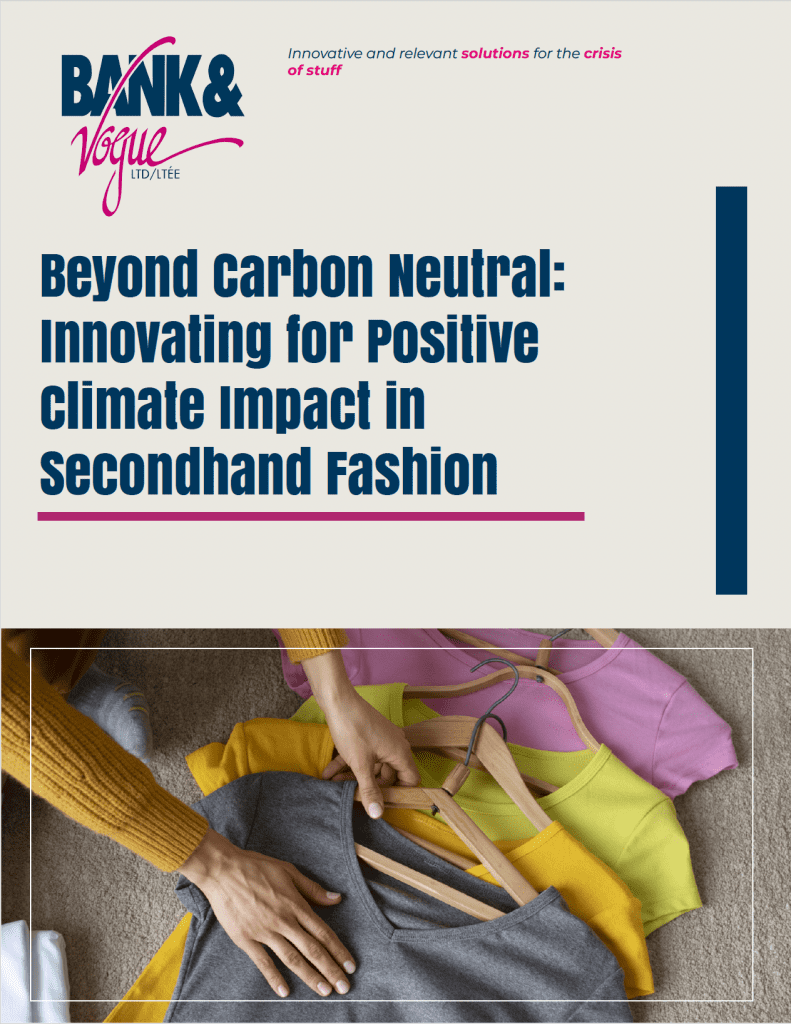Introduction
The global fashion industry faces increasing scrutiny for its environmental footprint, responsible for up to 10% of global greenhouse gas emissions. While carbon neutrality—achieving a balance between emitted and offset carbon—has become a critical goal, forward-thinking organizations are now looking beyond neutrality to achieve a net positive climate impact. For the secondhand fashion sector, this shift represents a unique opportunity to lead the industry toward regenerative and climate-positive practices.
This whitepaper explores innovative approaches, including carbon insetting, regenerative textile reuse, and circular supply chains, to transform secondhand fashion into a model for proactive climate solutions.
The Case for Net Positive Climate Impact
Beyond Neutrality: Why It Matters
- Mitigating Climate Change: Neutrality stabilizes emissions but does not address existing environmental damage. Net positive strategies actively reverse ecological harm.
- Consumer Demand: Eco-conscious consumers increasingly expect brands to lead with sustainable practices, driving demand for climate-positive solutions.
- Regulatory Pressure: Governments and organizations are implementing stricter carbon reduction mandates, incentivizing businesses to adopt more ambitious sustainability goals.
Secondhand Fashion’s Unique Position
The secondhand sector already reduces waste and extends product lifecycles, offering significant carbon savings compared to new garment production. By building on these inherent advantages, secondhand fashion can lead the charge toward net positive practices.

Key Innovations for Net Positive Impact
1. Carbon Insetting
Unlike offsets, which mitigate emissions outside the value chain, insetting focuses on reducing emissions within an organization’s operations. For the secondhand fashion industry, this could include:
- Green Logistics: Transitioning to electric or biofuel-powered transport for the movement of textiles.
- Renewable Energy: Powering sorting and processing facilities with renewable energy sources like solar or wind.
- Waste Minimization: Implementing advanced sorting technologies to ensure higher reuse rates and minimize landfill contributions.
2. Regenerative Practices in Textile Reuse
Regenerative practices aim to restore ecosystems and sequester carbon. Examples include:
- Material Reprocessing: Using cutting-edge recycling methods to transform worn-out textiles into high-quality fibers.
- Soil Health Initiatives: Partnering with agriculture-focused projects to turn textile waste into compostable materials that enrich soils and capture carbon.
- Biodiversity Projects: Collaborating with initiatives that restore habitats affected by textile production.
3. Circular Supply Chains
A fully circular supply chain ensures materials are continuously reused, eliminating waste and reducing the need for virgin resources. Steps include:
- Designing for Longevity: Promoting garments designed for durability and easy repair.
- Closed-Loop Systems: Establishing take-back programs where used garments are collected, sorted, and reintroduced into the supply chain.
- Data-Driven Optimization: Leveraging analytics to predict demand and reduce overproduction and waste.
Case Studies: Leading by Example
Case Study 1: Green Logistics in Secondhand Clothing
Hellmann Logistics introduced a carbon insetting solution by utilizing Sustainable Marine Fuel bunkered by HMM. This innovative approach replaces traditional fossil fuels with cleaner, sustainable alternatives, actively reducing the carbon footprint of logistics operations (Hellmann Logistics, 2023).
Case Study 2: Regenerative Agriculture in Fashion
The “Regenerative Fashion Futures” report highlights case studies of regenerative approaches in India and Bangladesh, where initiatives restored biodiversity and improved soil health in areas impacted by textile production (Regenerative Fashion Report, 2023).
Case Study 4: The Lowest Ever Carbon Converse Shoes Collaboration
Converse, in collaboration with Beyond Retro and Bank & Vogue Holdings (BVH),has been developing “The Lowest Ever Carbon Converse Shoes” since the first collaborations in 2019. This initiative sourced upcycled materials from Beyond Retro and BVH, significantly reducing the shoe’s carbon footprint. By incorporating secondhand textiles into a scalable manufacturing process, the partnership demonstrated how upcycling can align with large-scale production while achieving a climate-positive impact (Converse, 2023).

Steps Toward Climate Positivity
- Assess Current Impact: Conduct a full lifecycle analysis to identify carbon hotspots and areas for improvement.
- Set Ambitious Goals: Aim for beyond-neutral targets, aligning with science-based and net-positive frameworks.
- Invest in Technology: Adopt AI-driven sorting systems, low-impact transportation, and innovative recycling technologies.
- Foster Collaboration: Partner with NGOs, governments, and businesses to amplify efforts and share resources.
- Engage Stakeholders: Communicate transparently with customers, investors, and partners about climate-positive initiatives.
Conclusion: Leading the Climate-Positive Movement
Achieving a net positive climate impact is not just an environmental imperative but a competitive advantage in the secondhand fashion industry. By adopting carbon insetting, regenerative practices, and circular supply chains, companies can redefine sustainability while driving growth and profitability.
Bank & Vogue is committed to supporting businesses in the secondhand industry as they transition to proactive climate solutions. Contact us to learn how we can collaborate to achieve net positive outcomes and redefine the future of fashion sustainability.
Contact Us
For more information or support, reach out to Bank & Vogue







